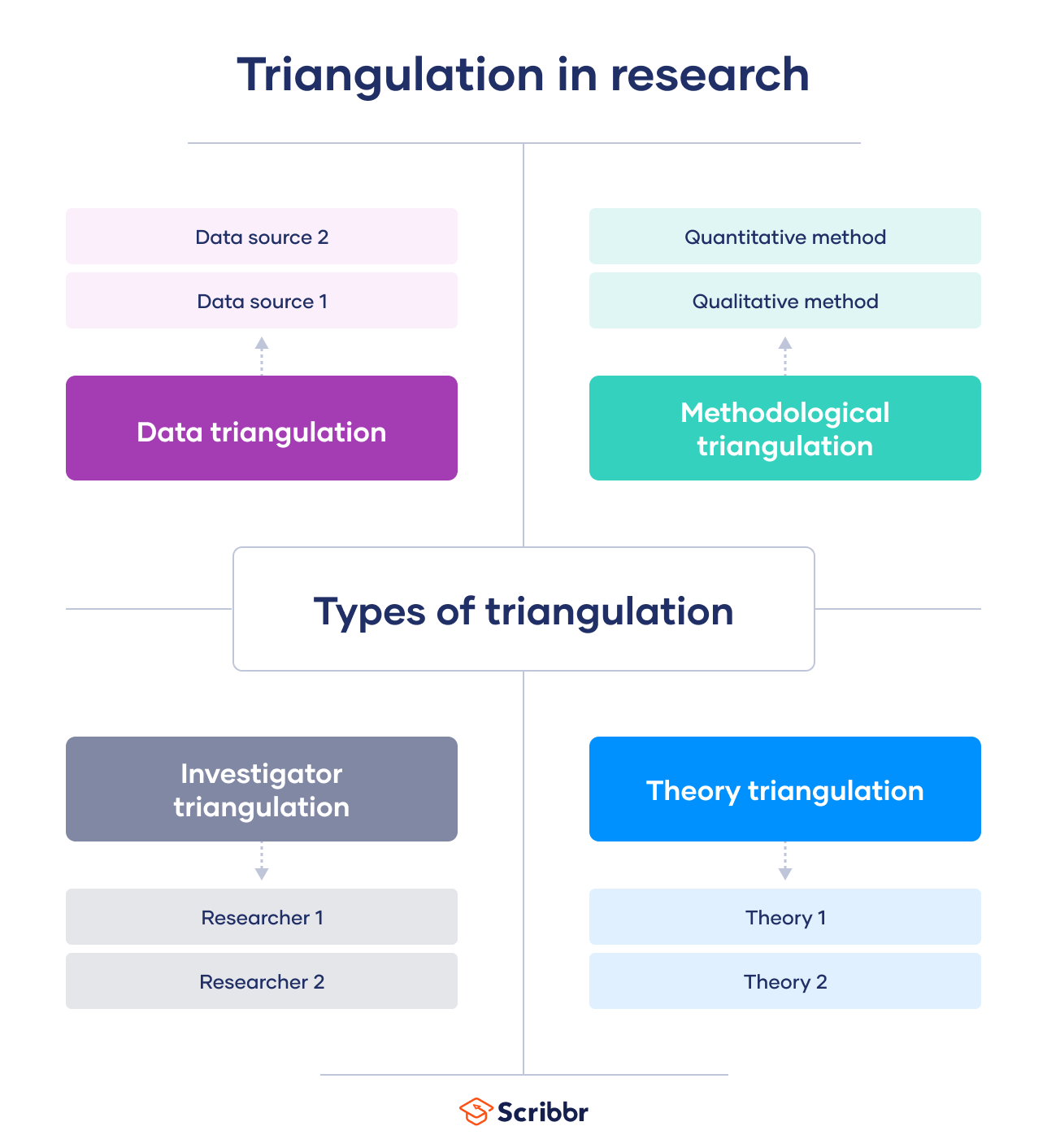Triangulation in Research | Guide, Types, Examples
Triangulation in research means using multiple datasets, methods, theories and/or investigators to address a research question. It’s a research strategy that can help you enhance the validity and credibility of your findings.
Triangulation is mainly used in qualitative research, but it’s also commonly applied in quantitative research. If you decide on mixed methods research, you’ll always use methodological triangulation.
- Qualitative research: You conduct in-depth interviews with different groups of stakeholders, such as parents, teachers, and children.
- Quantitative research: You run an eye-tracking experiment and involve three researchers in analysing the data.
- Mixed methods research: You conduct a quantitative survey, followed by a few (qualitative) structured interviews.
Types of triangulation in research
There are four main types of triangulation:
- Data triangulation: Using data from different times, spaces, and people
- Investigator triangulation: Involving multiple researchers in collecting or analysing data
- Theory triangulation: Using varying theoretical perspectives in your research
- Methodological triangulation: Using different methodologies to approach the same topic
We’ll walk you through the four types of triangulation using an example. This example is based on a real study.
Methodological triangulation
When you use methodological triangulation, you use different methods to approach the same research question.
This is the most common type of triangulation, and researchers often combine qualitative and quantitative research methods in a single study.
Methodological triangulation is useful because you avoid the flaws and research bias that come with reliance on a single research technique.
Data triangulation
In data triangulation, you use multiple data sources to answer your research question. You can vary your data collection across time, space, or different people.
When you collect data from different samples, places, or times, your results are more likely to be generalisable to other situations.
Investigator triangulation
With investigator triangulation, you involve multiple observers or researchers to collect, process, or analyse data separately.
They also recalibrate the way they code behaviors intermittently for consistency.
Investigator triangulation helps you reduce the risk of observer bias and other experimenter biases.
Theory triangulation
Triangulating theory means applying several different theoretical frameworks in your research instead of approaching a research question from just one theoretical perspective.
- People cooperate for a sense of reward: they cooperate to feel good.
- People cooperate to avoid guilt: they cooperate to avoid feeling bad.
By gathering fMR data, you can investigate whether there’s more brain activity in reward-related or in guilt-averse brain areas when people cooperate.
Testing competing hypotheses is one way to perform theory triangulation. Using theory triangulation may help you understand a research problem from different perspectives or reconcile contradictions in your data.
What is the purpose of triangulation?
Researchers use triangulation for a more holistic perspective on a specific research question. Triangulation is also helpful for enhancing credibility and validity.
To cross-check evidence
It’s important to gather high-quality data for rigorous research. When you have data from only one source or investigator, it may be difficult to say whether the data are trustworthy.
But if data from multiple sources or investigators line up, you can be more certain of their credibility.
Credibility is about how confident you can be that your findings reflect reality. The more your data converge, or or agree with each other, the more credible your results will be.
For a complete picture
Triangulation helps you get a more complete understanding of your research problem.
When you rely on only one data source, methodology, or investigator, you may risk bias in your research. Observer bias may occur when there’s only one researcher collecting data. Similarly, using just one methodology means you may be disadvantaged by the inherent flaws and limitations of that method.
- Behavioral observations from a lab setting
- Self-report survey data from participants reflecting on their daily lives
- Neural data from an fMRI scanner during a cooperative task
Each of these methods measures different aspects of cooperative behaviors, either directly or indirectly.
It’s helpful to use triangulation when you want to capture the complexity of real-world phenomena. By varying your data sources, theories, and methodologies, you gain insights into the research problem from multiple perspectives and levels.
To enhance validity
Validity is about how accurately a method measures what it’s supposed to measure.
You can increase the validity of your research through triangulation. Since each method has its own strengths and weaknesses, you can combine complementary methods that account for each other’s limitations.
Finally, fMRI data can tell you more about hidden neural mechanisms without any participant interference. But this type of data is only valuable for your research when combined with the others.
By combining all three methods, you compensate for one method’s flaws with another’s strengths.
Pros and cons of triangulation in research
Like all research strategies, triangulation has both advantages and disadvantages.
-
Reduces bias
Triangulating data, methods, investigators, or theories helps you avoid the bias that comes with using a single perspective in your research. You’ll get a well-rounded look into the research topic when you use triangulation.
-
Establishes credibility and validity
Combining different methods, data sources, and theories enhances the credibility and validity of your research. You’ll be able to trust that your data reflect real life more closely when you gather them using multiple perspectives and techniques.
-
Time-consuming
Triangulation can be very time-consuming and labour-intensive. You’ll need to juggle different datasets, sources, and methodologies to answer one research question.
This type of research often involves an interdisciplinary team and a higher cost and workload. You’ll need to weigh your options and strike a balance based on your time frame and research needs.
-
Inconsistency
Sometimes, the data from different sources, investigators, methods may not line up to give you a clear picture. Your data may be inconsistent or contradict each other.
This doesn’t necessarily mean that your research is incoherent. Rather, you’ll need to dig deeper to make sense of why your data are contradictory. These inconsistencies can be challenging but may also lead to new avenues for further research.
Frequently asked questions about triangulation
Cite this Scribbr article
If you want to cite this source, you can copy and paste the citation or click the ‘Cite this Scribbr article’ button to automatically add the citation to our free Reference Generator.
Bhandari, P. (2023, January 16). Triangulation in Research | Guide, Types, Examples. Scribbr. Retrieved 13 April 2025, from https://www.scribbr.co.uk/research-methods/triangulation-in-research/

